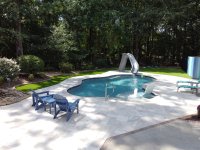Thanks
@Maverick23 for all the additional explanation, sorry for slow reply......
Carrier probably designed the HP this way to eliminate the cycling of the reversing valve
Thinking same

The weakness is in the racetrack design. The racetrack is two one way check valves and two solenoids. Looks like a race track thus the name. When activated for pool heating it prevents refrigerant from flowing the wrong way
I get it, thanks. While pursuing my epa608 cert I wound up with a couple racetrack diagrams pinned to my wall - still there! In those travels I just never ran across the racetrack term, it's a perfect description. Just more track options, controls and valves for the heat pump versions.
So the hotspot control panel uses all three of these wires to power the two AC/DC converters that converts the signal for the arduino controller to use. One is to power the arduino and the other is a voltage sense pin that is programmed. Problem is this sense pin is not isolated or disconnected on shutoff so it will continue to power the arduino. I wired a mechanical relay to break the connection when the Y signal drops at the thermostat. This was also hotspots suggestion which I think is a really garbage way to manage this flaw.
For starters I didn't even realize that FPH now uses an arduino these days, at least for heat pump versions. I've been answering questions about how it works, but my install, circa 2012, was vanilla and dated, so I need to season my replies given the updates! I'd be tempted to consider reprogramming the arduino in some way, or else adding some other logic - maybe via a simple programmable logic array PLA device - but you have the better grasp of all the logic!
Heater works great, it does in fact heat the pool. However when the pool temp nears 85 and up I don’t think it really saves energy. The compressor is essentially using hot water to condition the air which raises the refrigerant pressure and thus the watts consumed by the compressor. You are basically getting free heat though
That makes sense, and it's possible that the compressor current/load savings I reported were measured with cooler water, I'd have to re-check my data. I guess you still save a couple amps because the condenser cooling fan isn't running.
Another, perhaps remote possibility, is refrigerant overcharge that would raise the pressures and increase load. Not that you want to think about that

But it was always a mystery to me that FPH sized things without really addressing more detailed refrigerant volumes and whether they are equal when running in each mode. Back in the day FPH just recommended heat exchanger sizing based on A/C tonnage, but I always wondered if the system might be over or under charged in one mode or the other, even if only slightly, if the FPH exchanger used more or less volume than the existing condenser coils. I suppose careful measurements of subcooling and/or superheat values - compared to specified nameplate values on the heat pump - would verify that.
All of that assumes you have any interest in continuing the giant science project. Then it's like you work for FPH

Overall, am very glad it's working for you!







